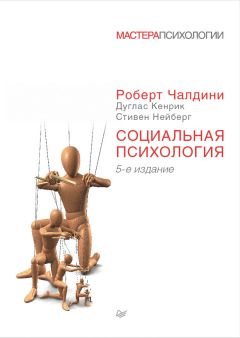Филип Зимбарго - Социальное влияние
Petty, R. £., and Cacioppo, J. T. (1984). The effects of issue involvement on responses to argument quantity and quality: Central and peripheral routes to persuasion. Journal of Personality and Social Psychology, 46, 69–81.
Petty, R.E., and Cacioppo, J. T. (1986). The elaboration likelihood model of persuasion. In L. Berkowitz (Ed.), Advances in experimental social psychology (vol. 19, pp. 123–205). New York: Academic Press.
Petty, R. E.. Cacioppo, J. Т., and Goldman, R. (1981). Personal involvement as a determinant of argument based persuasion. Journal of Personality and Social Psychology, 41, 847–855.
Petty, R. E., Wells. G. L., and brock, Т. С (1976). Distraction can enhance or reduce yielding to propaganda: Thought disruption versus effort justification. Journal of Personality and Social Psychology, 34, 874–884.
Pilisuk, M., and Parks, S. H. (1986). The healing web: Social networks and human survival. Hanover, NH: University Pressof New England.
Pratkanis, A. R., Eskenazi,]., and Green — wald.A. G. (1990). What you expect is what you believe (but not necessarily what you get): On the ineffectiveness of subliminal self — help audiotapes. Paper presented at the Western Psychological Association, Los Angeles, CA, April, 1990.
Pratkanis,A.R., and Greenwald, A. G. (1988). Recent perspectives on unconscious processing: Still no marketing applications. Psychology and Marketing, 5, 337–353.
Pratkanis.A.R., and Greenwald, A. G. (1989). A sociocognitive model of attitude structure and function. In L. Berkowitz (Ed.), Advances in experimental social psychology (vol. 22, pp. 245–285). New York: Academic Press.
Pratkanis, A. R., Greenwald, A. G., Leippe, M. R., and Baumgardner, M. H. (1988). In search of reliable persuasion effects: III. The sleeper effect is dead. Long live the sleeper effect. Journal of Personality and Social Psychology, 54, 203–218.
Pyszczynski, Т., and Wrightsman, L. S. (1981). The effects of opening statements on mock jurors' verdicts in a simulated court case. Journal of Applied Social Psychology, 11, 301–313.
Qualter, Т.Н. (1962). Propaganda and psychological warfare. New York: Random House.
Ravenholt, R. T. (1985). Tobacco's impact on twentieth — century U.S. mortality patterns. American Journal of Preventive Medicine, 1,4–17.
Ray, M., and Ward, S. (1976). Experimentation for pretesting public health programs: The case of the anti — drug abuse campaigns. Advances in Consumer Research, 3, 278–286.
Reed, H. В., and Janis, I.L. (1974). Effects of a new — type of psychological treatment on smokers' resistance to warnings about health hazards. Journal of Consulting and Clinical Psychology, 42, 748.
Regan, D. T. (1971). Effects ofa favor and liking on compliance. Journal of Experimental Social Psychology, 7, 627–639.
Reis,A., and Trout, J. (1986). Positioning: The battle for your mind. New York: Warner.
Reyes, R. M., Thompson, W. C, and Bower, G. H. (1980). Judgmental biases resulting from differing availability of arguments. Journal of Personality and Social Psychology, 39, 2–12.
Roberts, D. F. (1982). Children and commercials: Issues, evidence, interventions. Prevention in Human Services, 2, 19–36.
Roberts, D. F., and Maccoby, N. (1985). Effects of mass communication. In G. Lindzey and E. Aronson (Eds.), Handbook of social psychology: Volume II (3d ed., pp. 539–598). New York: Random House.
Robinson,]., and McArthur, L. Z. (1982). Impact of salient vocal qualities on causal attributions for a speaker's behavior. Journal of Personality and Social Psychology, 43, 236–247.
Robles, R., Smith, R., Carver, С S., and Wel — lens, A. R. (1987). Influence of subliminal visual images on the experience of anxiety. Personality and Social Psychology Bulletin, 13, 399–410.
Rogers, С R. (1951). Client — centered therapy: Its current practice, implications and theory. Boston: Houghton — Mifflin.
Rogers, R. W. (1983). Cognitive and physiological processes in fear appeals and attitude change: A revised theory of protection motivation. In J. T. Cacioppo and R. E. Petty (Eds.), Social psychophysiology. New York: Guilford.
Rogers, R. W., and Mewborn, С R. (1976). Fear appeals and attitude change: Effects of a threat's noxiousness, probability of occurrence, and the efficacy of coping responses. Journal of Personality and Social Psychology, 34, 54–61.
Rohrer, J. H., Baron, S. H., Hoffman, E. L., and Swander, D. V. (1(954). The stability of auto — kinetic judgments. Journal of Abnormal and Social Psychology, 49, 595–597.
Rokeach, M. (1973). The nature of human values. New York: Free Press.
Ronis, D. L., Baumgardner, M. H., Leippe, M. R., Cacioppo, J. Т., and Greenwald, A. G. (1977). In search of reliable persuasion effects: I. A computer — controlled procedure for studying persuasion. Journal of Personality and Social Psychology, 35, 548–569.
Rosenhan, D. L. (1969). Some origins of the concerns for others. In P. Mussen and M. Covington (Eds.), Trends and issues in developmental psychology. New York: Holt, Rinehart & Winston.
Rosenkrans, M.A., and Hartup, W. W. (1967). Imitative influences of consistent and inconsistent response consequences to a model on aggressive behavior in children. Journal of Personality and Social Psychology, 7, 429–434.
Rosnow.R.L., and Suls, J..M. (1970). Reactive effects of pretesting in attitude research. Journal of Personality and Social Psychology, 15,338–343.
Ross, L. (1977). The intuitive psychologist and his shortcomings. In L. Berkowitz (Ed.), Advances in experimental social psychologv (vol. 10, pp. 173–220). New York: Academic Press.
Ross, L. (1988). Situationist perspectives on the obedience experiments. Review of A. G. Miller's The obedience experiments. Contemporary Psychology, 33, 101–104.
Ross, L., Amabile.T. M., and Steinmetz, J. L. (1977). Social roles, social control, and biases in social — perception processes. Journal of Personality and Social Psychology, 35, 485–494.
Ross, L., and Anderson, С. А. (1980). Shortcomings in the attribution process: On the origins and maintenance of erroneous social assessments. In A.Tversky, D. Kahneman, and P. Slovic (Eds.), Judgment under uncertainty: Heuristics and biases. New York: Cambridge University Press.
Ross, I., Lepper, M. R., and Hubbard, M. (1975). Perseverance in self perception and social perception: Biased attributiona! processes in the debriefing paradigm. Journal of Personality and Social Psychology, 32, 880–892.
Ross,M. (1975). Salience of reward and intrinsic motivation. Journal of Personality and Social Psychology, 32, 245–254.
Rothschild, M. L. (1987). Advertising. Lexington, MA: Heath.
Rule, B. G., and Bisanz, G. L. (1987). Goals and strategies of persuasion: A cognitive schema for understanding social events. In M. P. Zanna, J. M. Olson, and С. Р. Herman (Eds.), Social influence: The Ontario symposium (vol. 5, pp. 185–206). Hillsdale, NJ: Erlbaum.
Rushton, J. P. (1975). Generosity in children: Immediate and long — term effects of modeling, preaching and moral judgment. Journal of Personality and Social Psychology, 31, 459–466.
Rushton, J. P., and Campbell, A. С. (1977). Modeling, vicarious reinforcement and extraversion on blood donating in adults: Immediate and long — term effects. European Journal of Social Psychology, 7, 297–306.
Ryan, W. (1971). Blaming the victim. New York: Pantheon.
Sakarai, M. M. (1975). Small group cohesiveness and detrimental conformity. Sociometry, 38, 340–357.
Saks, M. J., and Hastie, R. (1978). Social psychology in court. New York: Van Nostrand Reinhold.
Salancik, G. R., and Conway, M. (1975). Attitude inferences from salient and relevant cognitive content about behavior. Journal of Personality and Social Psychology, 32, 829–840.
San Francisco Chronicle (1990). Jan. 29.
San Francisco Chronicle (1990). Feb. 20.
San Francisco Examiner and Chronicle (1990). Feb. 12.
Santee, R. Т., and Jackson, S. E. (1982). Sex differences in the evaluative implications of conformity and dissent. Social Psychology Quarterly, 45, 121–125.
Santee, R. Т., and Maslach, С. (1982). To agree or not to agree: Personal dissent amid social pressure to conform. Journal of Personality and Social Psychology, 42, 690–700.
Saxe, L., Dougherty, D., and Cross, T. (1985). The validity of polygraph testing: Scientific analysis and public controversy. American Psychologist, 40, 355–366.
Schachter, S. (1951). Deviation, rejection, and communication. Journal of Abnormal and Social Psychology, 46, 190–207.
Scherer,K.R., Feldstein, S., Bond, R.N., and Rosenthal, R. (1985). Vocal cues to deception: A comparative channel approach. Journal of Psycholinguistic Research, 14, 409–425.
Schlenker, B. R. (1982). Translating actions into attitudes: An identity — analytic approach to the explanation of social conduct. In L. Berkowitz (Ed.), Advances in experimental social psychology (vol. 15, pp. 151–181). New York: Academic Press.
Schooler, J. W., Gerhard, D., and Loftus, E. F. (1986). Qualities of the unreal. Journal of Experimental Psychology: Learning, Memory and Cognition, 11, 171–181.
Schulman, J., Shaver, P., Colman, R., Emrich, В., and Christie, R. (1973). Recipe for a jury. Psychology Today, May, 37–44, 77–84.
Schultz, D. P. (1982). Psychology and industry today: An introduction to industrial and organizational psychology (3d ed.). New York: Macmillan.
Schwartz, R. M., and Garamoni, G. L. (1986). A structural model of positive and negative states of mind: Asymmetry in the internal dialogue. In P.C.Kendall (Ed.), Advances in cognitive — behavioral research and therapy (vol. 5, pp. 2–63). New York: Academic Press.
Schwarzwald, J., Bizman, A., and Raz, M. (1983). The foot — in — the — door paradigm: Effects of second request size on donation probability and donor generosity. Personality and Social Psychology Bulletin, 9, 443–450.
Scrivner, E., and Safer, M. A. (1988). Eyewitnesses show hyperkinesia for details about a violent event. Journal of Applied Psychology, 73, 371–377.
Sears, D. O., and Freed man, J. L. (1967). Selective exposure to information: A critical review. Public Opinion Quarterly, 31, 194–213.
Seligman, M. E. P. (1975). Helplessness: On depression, development, and death. San Francisco: Freeman.
Seligman, M. E. P., and Schulman, P. (1986). Explanatory style as predictor of productivity and quitting among life insurance agents. Journal of Personality and Social Psychology, 50, 832–838.
Shapiro, S., Skinner, E. A., Kesster, L. G., Korjf, M., Von German, P. S., Tischler, F. L., Leaf, P. /., Benham, L., Cottier, L., and Regier, D.A. (1984). Utilization of health and mental health services. Archives of General Psychiatry, 41, 971–978.
Sheridan, С L., and King, R. G. (1972). Obedience to authority with a genuine victim. Proceedings of the 80th annual convention of the American Psychological Association, Los Angeles.
Sherif, С W., Kelly, M., Rodgers, H. L., Jr., Sarup, C, and Tittler, B. I. (1973). Personal involvement, social judgment, and action. Journal of Personality and Social Psychology, 27, 311–328.
Sherif, M. (1936). The psychology of social norms. New York: Harper & Row.
Sherif, M., and Hovland, С 1. (1961). Social judgment: Assimilation and contrast effects in communication and attitude change. New Haven, CT: Yale University Press.
Sherman, S. J. (1987). Cognitive processes in the formation, change, and expression of attitudes. In M. P. Zanna, J. M. Olson, and С. Р. Herman (Eds.), Social influence: The Ontario symposium (vol. 5, pp. 75–106). Hillsdale, NJ: Erlbaum.
Sherman, S.J., and Gorkin,L. (1980). Attitude bolstering when behavior is inconsistent with central attitudes. Journal of Experimental Social Psychology, 16, 388–403.
Sherman, S. J., Presson, С. C, Chassin, L., Ben — senberg. M., Corty,E., and Olshavsky, R. W. (1982). Smoking intentions in adolescents. Personality and Social Psychology Bulletin, 8, 376–383.
Shopland, D. R., and Brown, С (1987). Toward the 1990 objectives for smoking: Measuring the progress with 1985 NHIS data. Public Health Reports, 102, 68–73.
Sistrunk,F., and McDavid J.W. (1971). Sex variable in conformity behavior. Journal of Personality and Social Psychology, 17, 200–207.
Sivacek, L, and Crano, W. D. (1982). Vested interest as a moderator of attitude — behavior consistency. Journal of Personality and Social Psychology, 43, 210–221.
Smart, R. C, and Feger, D. (1974). The effects of high and low fear messages about drugs. Journal of Drug Education, 4, 225–235. Smith, M., Bruner, J., and White, R. (1956). Opinions and personality. New York: Wiley.




